Parliamentary election in Andorra, 2 April 2023
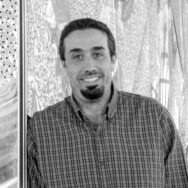
LLuís Medir
Associate professor at Universitat de BarcelonaIssue
Issue #4Auteurs
LLuís Medir
Issue 4, January 2024
Elections in Europe: 2023
Andorra is a landlocked micro-state (81,588 inhabitants in 2022 and 468 km2) located in the heart of the Pyrenees between France and Spain. Andorra is a unique case in Europe, especially in view of its medieval political heritage (Medir, Vilanova & Pano 2022). Contemporary Andorra is an independent and sovereign state and a member state of the United Nations, but also a parliamentary co-principality headed by two Co-Princes, the Bishop of Urgell and the President of the French Republic, who do not hold executive power. This exceptional institutional arrangement dates back to 1278, when the Pareatges, a peace pact between the Bishop of Urgell and the Count of Foix, was signed (Mickoleit 2010). Meanwhile, Andorra’s struggle for neutrality between its two powerful neighbors has contributed to its territorial and social stability for almost eight centuries. Andorra retains Catalan as its official language and most of its traditions and customary rules have remained alive since feudal times. Andorra’s political regime is characterized by the solidity and political importance of its municipalities, known as parishes or comuns (their official name according to the constitution).
Andorra currently has 7 parishes that can be considered Andorra’s political « soul », as there was no functioning central state apparatus until the liberal-democratic constitution of 1993 was adopted (Medir, Vilanova and Pano 2022). In fact, the constitutional nature of Andorra’s local governments places them in a situation somewhat similar to that of the Swiss cantons: they are institutions with a broad set of competencies, their own budget and, most importantly, a strong political influence on the national scene. Indeed, local governments participate in national policy-making through various constitutional channels and institutions (Bartomeu 2010). As we will see, their influence on the national election is also crucial.
The latest election to the Consell General, the Andorran legislature, was held on April 2 in the context of a highly relevant political process: the possible adoption of Andorra’s association agreement with the EU, which could significantly and lastingly change Andorran politics and society. The impact of the future agreement on Andorran society has been compared by some to the consequences of the approval of the current constitutional norm in 1993. The outgoing (and current) head of government, Xavier Espot, of the Demòcrates per Andorra (DA) party, has been one of the architects of the current negotiation, which began in 2015. The agreement would grant the Principality access to the Internal Market of the twenty-seven (including the free movement of people, goods, services and capital), while taking into account some of the specific needs of the Andorran micro-state. 1
The election took place in a highly fragmented party space, which saw up to 8 different political forces (when counting local coalitions separately) compete for the Council’s 28 seats. While the Andorran party system is nominally volatile, elite coalitions are relatively stable over time (Serra, 2015 and Minoves, 2022). This high fragmentation of the party space is largely the result of the electoral system of Andorran general elections, which involves a double ballot box or double list method. In the same election, citizens have two votes: one national and one parish vote. Fourteen general councilors are elected in a national constituency by proportional representation from closed and blocked lists using the largest remainder method (Hare quota); another fourteen are elected in parish constituencies via single-round first-part-the-post voting, with each parish electing 2 deputies regardless of its population. Parish votes are not cast for individual candidates but for two-person tickets, with the two candidates of the winning ticket being elected together. Each citizen can cast one vote for a national list and one vote for a candidate ticket in his parish. The absolute majority needed to form a stable executive is 15 councilors.
After the 2019 election, as the result of high partisan fragmentation, a government coalition composed of 3 parties was formed. The parliamentary majority backing the president of the government was formed by the president’s own party, DA, with 11 councilors, the Liberals d’Andorra (LdA), Ciutadans Compromesos and later Acció (AC), a split of LdA. The main opposition party was the Partit Socialdemòcrata d’Andorra (PS), along with two minor parties. In total, in 2019, 8 parties ran in the national constituency, while 6 other parties or coalitions ran only in parish constituencies.
As mentioned above, the 2023 campaign was marked by the negotiations of the association agreement with the EU, but also by issues such as abortion (with one of the two co-princes of Andorra, the Bishop of La Seu d’Urgell, adopting a very critical stance), the welfare state and social security. With the irruption of new political formations such as Concòrdia (CC) and Andorra Endavant (AE), new political issues became prominent in the campaign. Concòrdia is a party of Andorran nationalist ideology that develops a new discourse on the nature and function of the Andorran state. Its political program, which combines demands for more transparency, gender equality and economic liberalism with an agenda for developing a comprehensive social protection model, has sparked new debates in this election. In general, the Andorran ideological spectrum is dominated by liberal-conservative parties (Demòcrates per Andorra, Liberals d’Andorra, Ciutadans Compromesos), with a historical presence of social-democratic parties (in 2023 the various forces of this space, such as the Partit Socialdemòcrata and Socialdemocràcia i Progrés d’Andorra, ran together), and new parties with a lower ideological profile embodying strong demands for political change (Concòrdia and Andorra Endavant).
With a turnout slightly below the national average and evenly distributed territorially (66.9% in both polls, see Figure a), the 2023 election resulted in a clear victory for Xavier Espot’s DA, thus reinforcing his parliamentary majority and ensuring his reelection as President of the Government (Minoves 2023). Specifically, DA obtained a broad absolute majority due to its outstanding victory in the national vote (see “the data” panel for national constituency results) but also, and perhaps most importantly, due to its victory in 6 of the 7 parishes (La Massana, Ordino, Canillo, Andorra la Vella, Encamp and Escaldes) which helped it secure a total of 11 parish councilors. 2 DA obtained 5 additional seats at the national level, for a total of 16 representatives in the General Council. Only the parish of Sant Julià differed, with Concòrdia winning the two local constituency seats there (see Figure b).
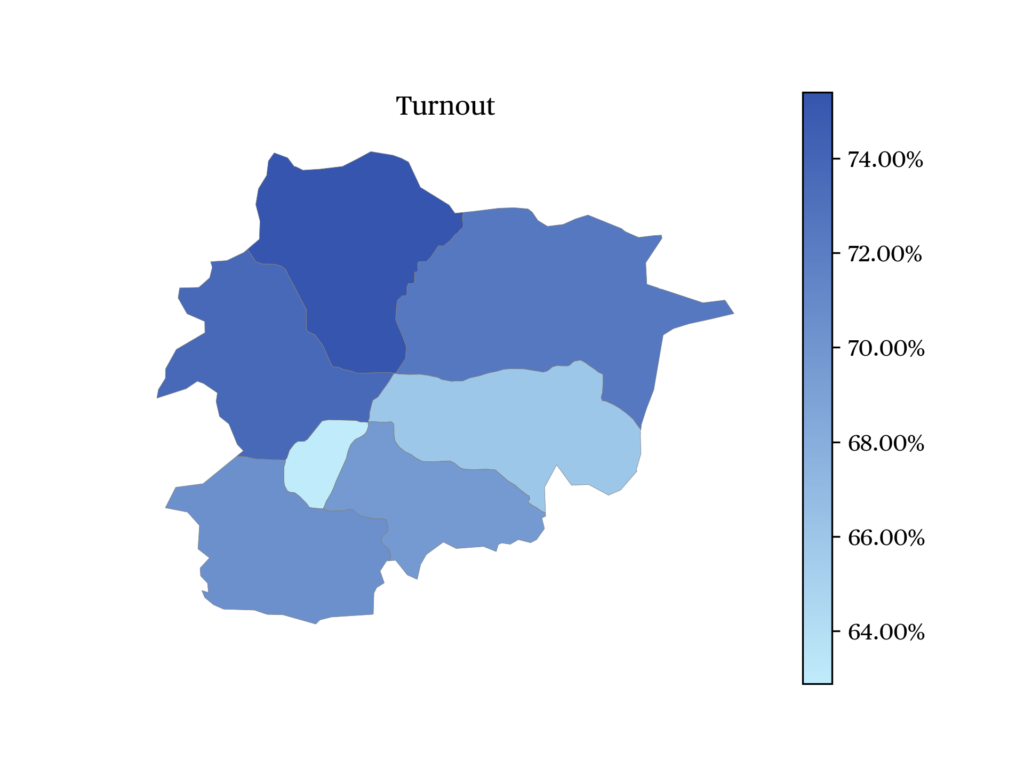
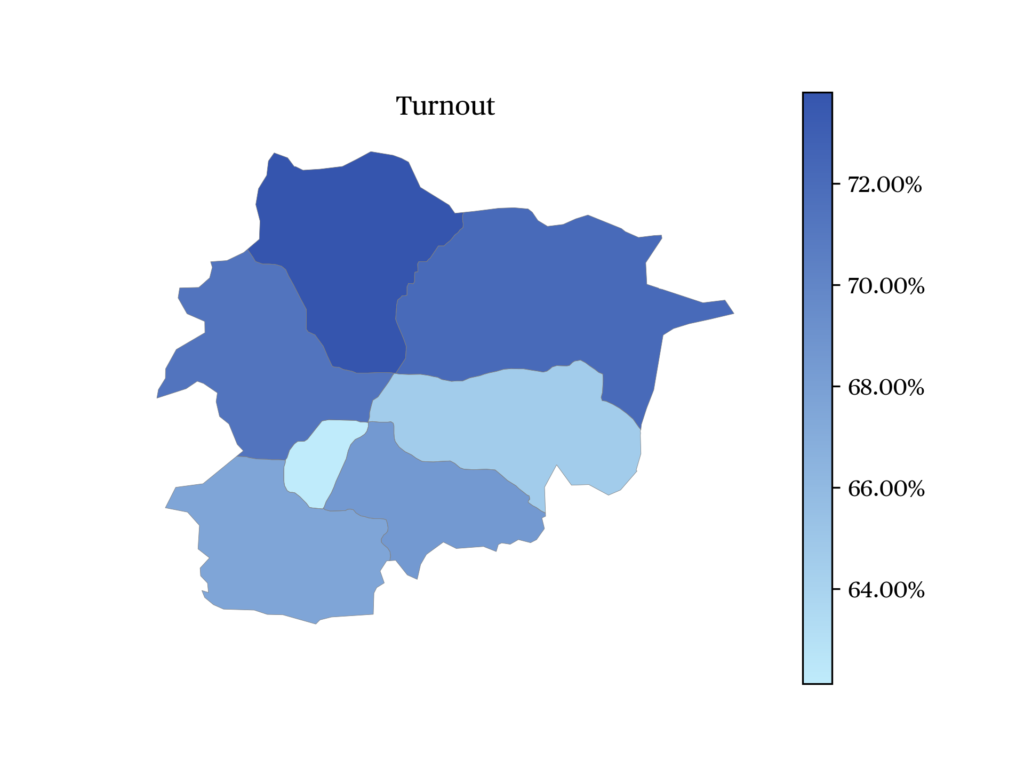
The chart in “the data” shows the evolution of the parties’ vote share in the national constituency from 2019 to 2023. The territorial distribution of the vote in 2023 and the evolution in the number of representatives is reported in Figure c. When comparing the results of the last two elections, three key differences stand out. First, the data attests to the electoral gains of the governing DA party, which went from securing only a plurality to controlling an absolute majority in the legislature, despite a slight loss in popular vote in the national constituency (which was more than offset by its good results in parish constituencies). Secondly, we witness the emergence of a new party, Concòrdia, which combines Andorran nationalism with a modernized political agenda. Thirdly, the data suggests that the emergence of Concòrdia has occurred largely at the expense of the Social Democratic Party which, despite forming a single platform with other social democratic and progressive parties for the first time in many years, lost its position as the first opposition party, going from 7 councilors in 2019 to 3 in 2023. Overall, the configuration of political forces competing in the 2023 election was remarkable, with 4 of the 6 parties or coalitions present in the national constituency being new with respect to 2019.
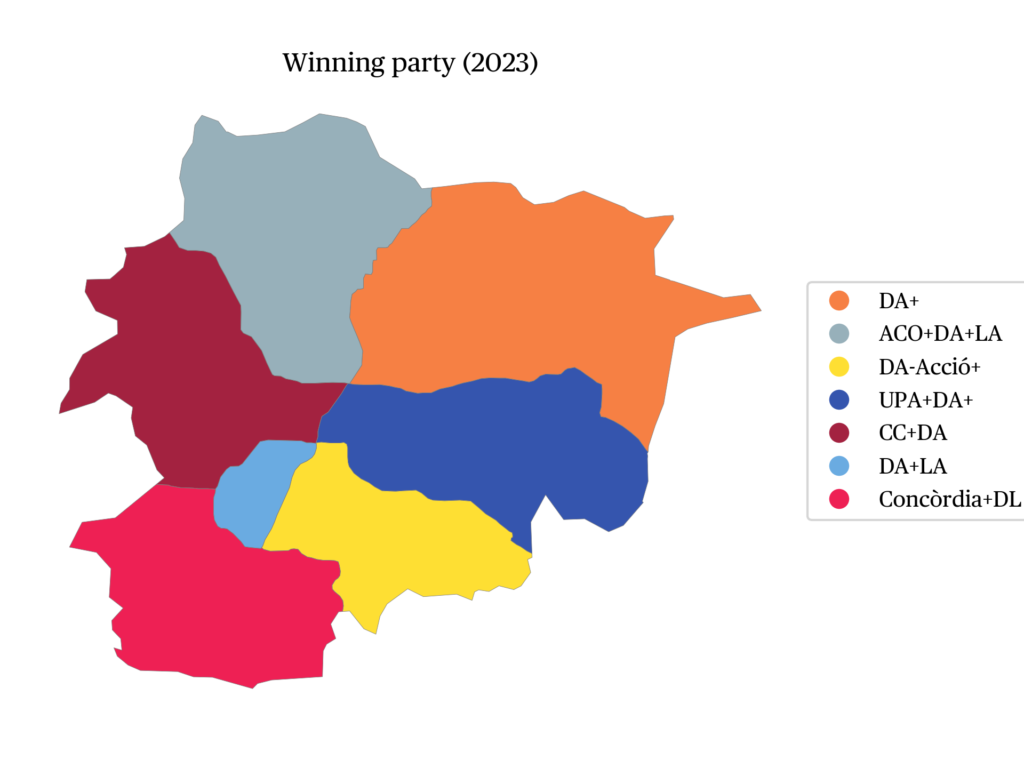
Together with the consolidation of DA and the collapse of both PS and Liberals d’Andorra 3 , the emergence of Concòrdia is the third remarkable phenomenon of this election. Concòrdia, headed by Cerni Escalé, is a young party whose leaders are political newcomers in their thirties. Among them are political scientists and economists, many of whom have studied abroad. Together, they managed to create, in a very short time, a horizontal and assembly-based political project that combines the defense of Aindorran nation, Catalanism, and an eclectic ideology (with measures that could be classified as right-wing but at the same time anchored in an ideal of social cohesion and justice). Despite not having any previous institutional experience, they are now leading the opposition to the Espot government.
The role played by local (parish) dynamics in national elections cannot be overemphasized. DA’s 2023 victory, in particular, is strongly anchored in local dynamics. The strength of its local candidates was the party’s main asset, with first-past-the-post voting amplifying the effects of its local dominance. DA was also the only party to present parish candidates in each of the 7 communes, and it obtained more votes in the parish lists than in the national list. On the other hand, the performance of new forces such as Concòrdia and Andorra Endavant is mostly based on their good results in the national constituency, where obtaining representation is less costly and the influence of national elites is weaker. Andorra’s dual voting system produces different result in the national and in the parochial ballot box, with a significantly larger share of blank votes in the latter due to some parties not presenting parochial tickets.
| Party | Votes nat. | % nat. | Seats nat. | Votes par. | % par. | Seats par. | Change |
| Demòcrates per Andorra | 6262 | 32,66 | 5 | 7309 | 11 | 16 | +5 |
| Concòrdia | 4109 | 21,43 | 3 | 3516 | 2 | 5 | +5 |
| Partit Socialdemòcrata–Progressistes SDP | 4036 | 21,05 | 3 | 5238 | 0 | 3 | -4 |
| Andorra Endavant | 3067 | 16 | 3 | 1370 | 0 | 3 | +3 |
| Liberals d’Andorra | 893 | 4,66 | 0 | 3007 | 0 | 0 | -4 |
| Acció | 805 | 4,2 | 0 | 1979 | 1 | 1 | +1 |
| Blank votes | 537 | – | – | 1527 | – | – | – |
| Invalid votes | 341 | – | – | 557 | – | – | – |
| Total | 20050 | 100 | 14 | 20043 | 14 | 28 | |
| Turnout | 29958 | 66,93 | – | 29958 | 66,9 | – | – |
Source: https://www.eleccions.ad/resultats; nat. = national constituency, par. = parish constituencies
In conclusion, the 2023 election has consolidated the parliamentary support of the Demòcrates per Andorra government and given it strong legitimacy to govern the country in the next four years. The government will be able to rely on a solid parliamentary majority to face the profound societal changes that the likely ratification of the cooperation agreement with the EU will bring about. The agreement is expected to consolidate the existence of an EU-European microstates framework agreement, common to Monaco, San Marino and Andorra, with country-specific protocols for each of them. This evolution, if it materializes, will also have a lasting impact on Andorran politics. The holding of a referendum on the ratification of the association agreement, promised by DA during the campaign, is still pending confirmation.
In parallel to this stability, the 2023 election has shown interesting signs of change that should be consolidated in the next four years and that can also impact the future of Andorran politics. This includes the emergence of Concòrdia and Andorra Endavant, two parties with a new leadership embodying real demands for change; the internal renovation process that the Partit Socialdemòcrata (and the different sensibilities that it has allied with in this election) will have to carry out following its electoral defeat; and the delicate situation of the Liberals d’Andorra, now represented in parliament by a single councilor.
Finally, we note that the double ballot-box system has generated a very remarkable political stability, which clearly reinforces the local elites and has penalized the reformist options that gained momentum in the proportional ballot. Together, Concòrdia and Andorra Endavant, the two parties that championed the deepest political change (and not only alternation in power, as was the case of the Partit Socialdemòcrata), have gathered more popular votes than the Demòcrates per Andorra. In a certain way, we can observe that the desire for political change still has to be translated into the representation system.
The Data
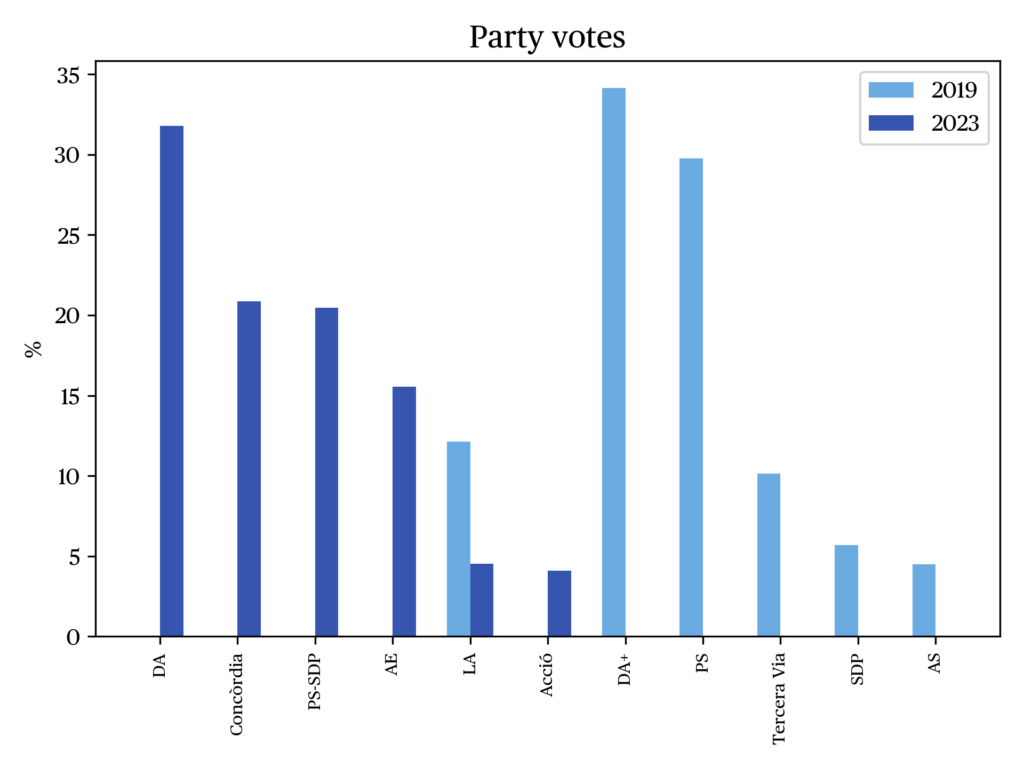
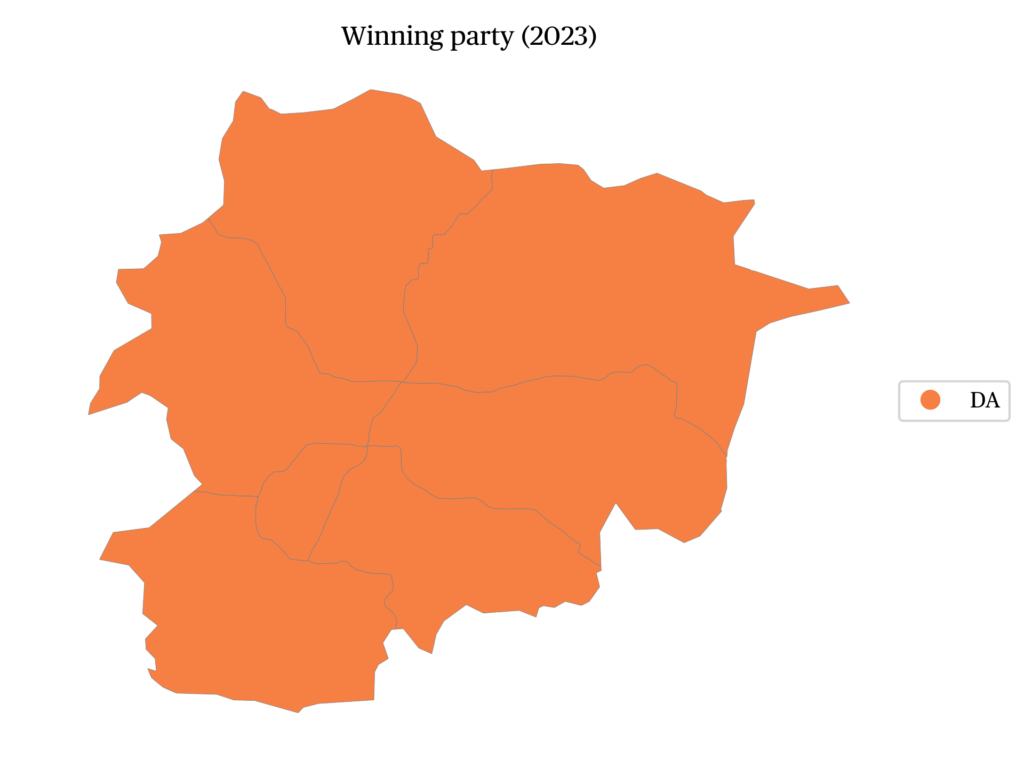


References
Bartomeu, I. (2010). Introducció al Sistema Constitucional del Principat d’Andorra. Andorrana, SA: Fundacio Julià reig i Premsa.
Medir, L., Vilanova, P., & Pano, E. (2022). Andorra: Local elections in quasi-federal institutions. In The Routledge Handbook of Local Elections and Voting in Europe (pp. 187-196). Routledge.
Mickoleit, A. (2010). Andorra. In D. Nohlen& P. Stöver (eds.), Elections in Europe: A data handbook (pp. 149–168). Baden-Baden: Nomos Verlagsgesellschaft.
Minoves-Triquell, J. (2022). The Evolution of Andorra’s Party System: From Parties of ‘Notables’ to a Predominant Party System. In Casal Bértoa, F., & Dumont, P. (eds.), Party Politics in European Micro-states. Abingdon/New York: Routledge.
Minoves-Triquell, J. (2023). Andorra’s 2023 elections: DA wins an absolute parliamentary majority. PSGo blog. Online.
Serra, J. (2015). Volatilidad y legitimidad del sistema de partidos del Principado de Andorra; dos dimensiones de la institucionalización de su sistema de partidos. Ponencia Congreso AECPA. Online.
Notes
- See https://andorraue.ad/es/accord-dassociacio.
- In one parish, the DA ran on a joint ticket with an Acció party member.
- The liberals are now represented by a single non-attached MP who joined the General Council after Conxita Marsol joined Espot’s executive. MP and executive mandates are legally incompatible.
citer l'article
LLuís Medir, Parliamentary election in Andorra, 2 April 2023, Nov 2023,
à lire dans cette issue
voir toute la revue





